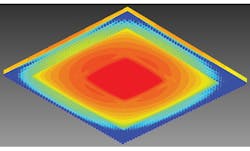Detailed Thermal Models Benefit IC Package Designs
Generating high-quality predictions of component temperatures can enable circuit and package designers to optimize their designs and avoid temperature-related failures. Various methods for thermally modeling components are available, and choosing the appropriate methods to balance simulation times and the fidelity of the prediction is a critical step. An application note by Mentor Graphics, “10 Tips For Predicting Component Temperatures… A High-Level ‘How To’ Guide,” discusses the benefits of a detailed thermal model along with a step-by-step approach to predictive thermal modeling.
This file type includes high resolution graphics and schematics when applicable.
Choosing the appropriate method of modeling for each component in the design could optimize the prediction simulation timing, as well as allow for more detailed analysis of higher-profile components. To simplify the model, low-power density components may be described using background thermal profiles, where larger components that disrupt airflow may need to be modeled with 3D techniques. High-power and large components may need to be evaluated in a detailed discrete basis. Using good power estimates for these components in initial thermal planning could save significant time and effort costs later in the design cycle.
A way to estimate the thermal effect of components early on when the final design is still nebulous is to use package thermal models, which can be increased in detail as the design progresses. Types of models include two-resistor, RC-ladder, DELPHI, and detailed. The thermal significance of the component often dictates the detail of the model. Sometimes, customized thermal models may be necessary. Using maps of the power distribution through the die could lead to more viable thermal predictions, along with calibrating model data using experimentally derived thermal profiles.
The final steps recommended in the note consider heatsink solutions, thermal interface material (TIM) resistance, and thermal profiles of mechanical stress prediction. Design considerations like pressure drop, the wake region formed by the heatsink, and increased contact area could lead to a custom solution being more thermally viable for the design. The thermal resistance of the TIM could be a significant contributor of junction temperature, and a quality thermal prediction could lead to a suitable TIM choice. Finally, thermally induced stress on the packaging and substrate of the die based on the application environment may be critical in design decisions. Finite-element stress tools that can import thermal strain as boundary conditions could be used to increase the accuracy of this analysis.
Mentor Graphics, 8005 SW Boeckman Road Wilsonville, OR 97070, +1-501-685-7000, www.mentor.com
About the Author
Jean-Jacques DeLisle
Jean-Jacques graduated from the Rochester Institute of Technology, where he completed his Master of Science in Electrical Engineering. In his studies, Jean-Jacques focused on Control Systems Design, Mixed-Signal IC Design, and RF Design. His research focus was in smart-sensor platform design for RF connector applications for the telecommunications industry. During his research, Jean-Jacques developed a passion for the field of RF/microwaves and expanded his knowledge by doing R&D for the telecommunications industry.


